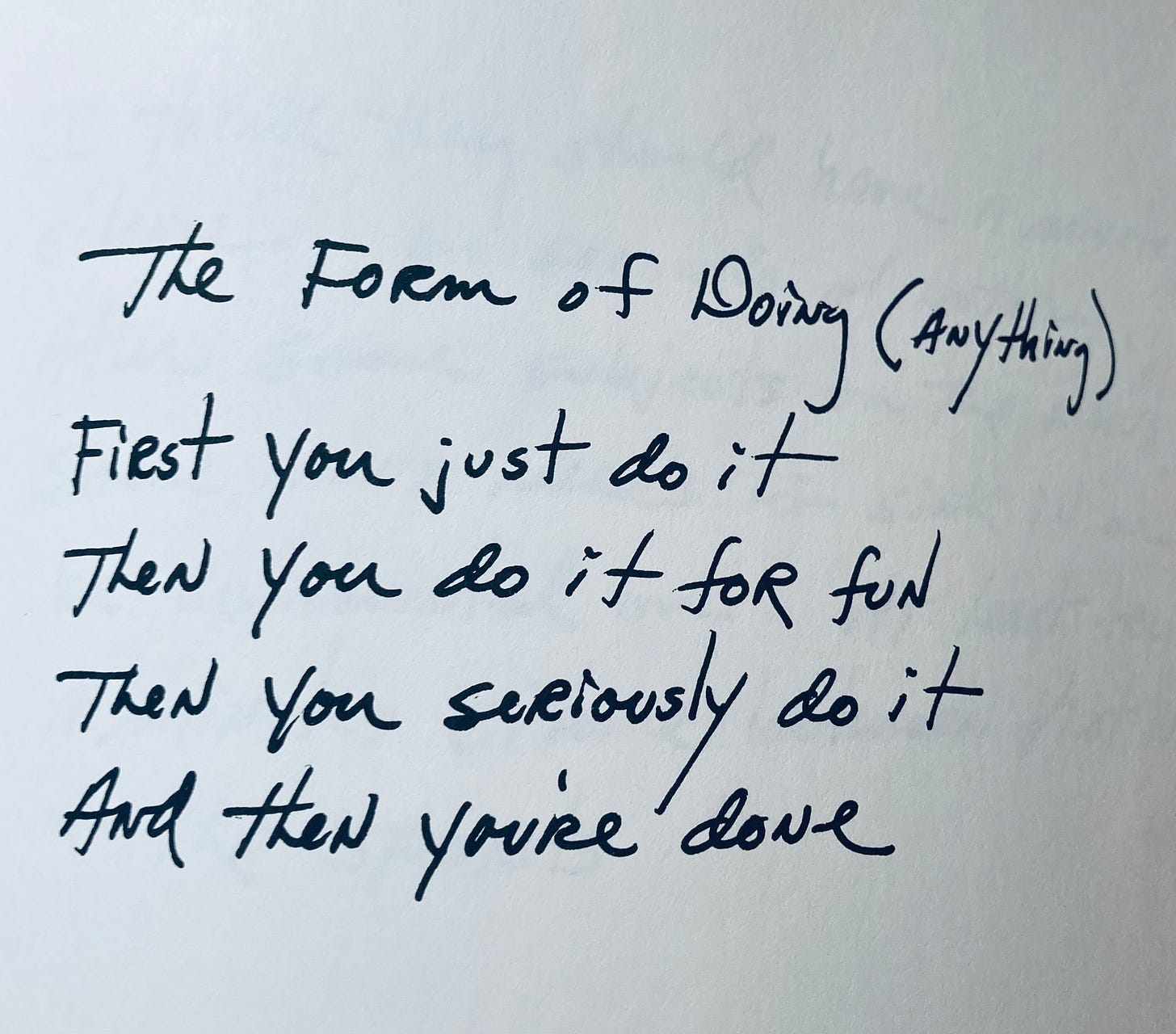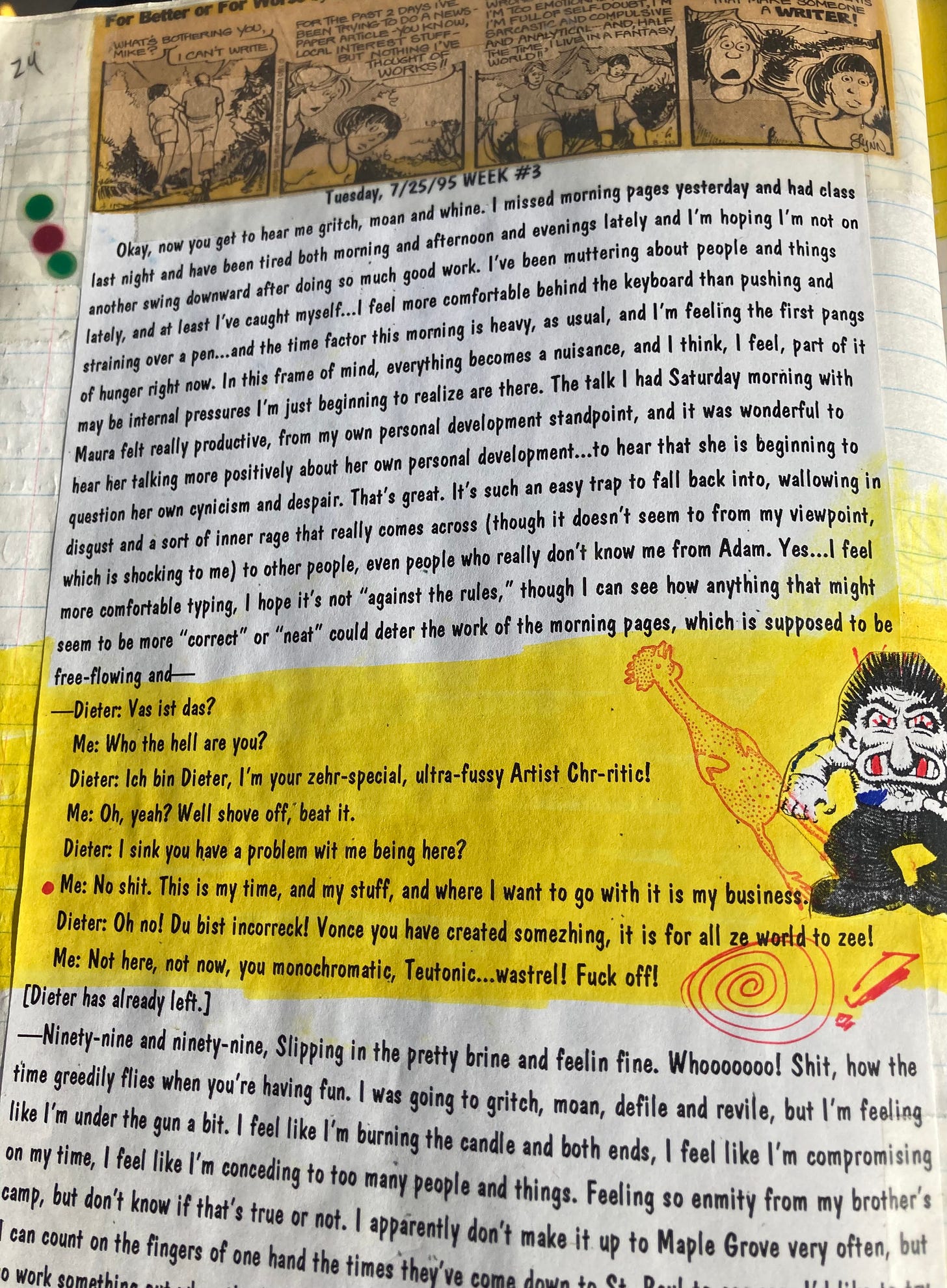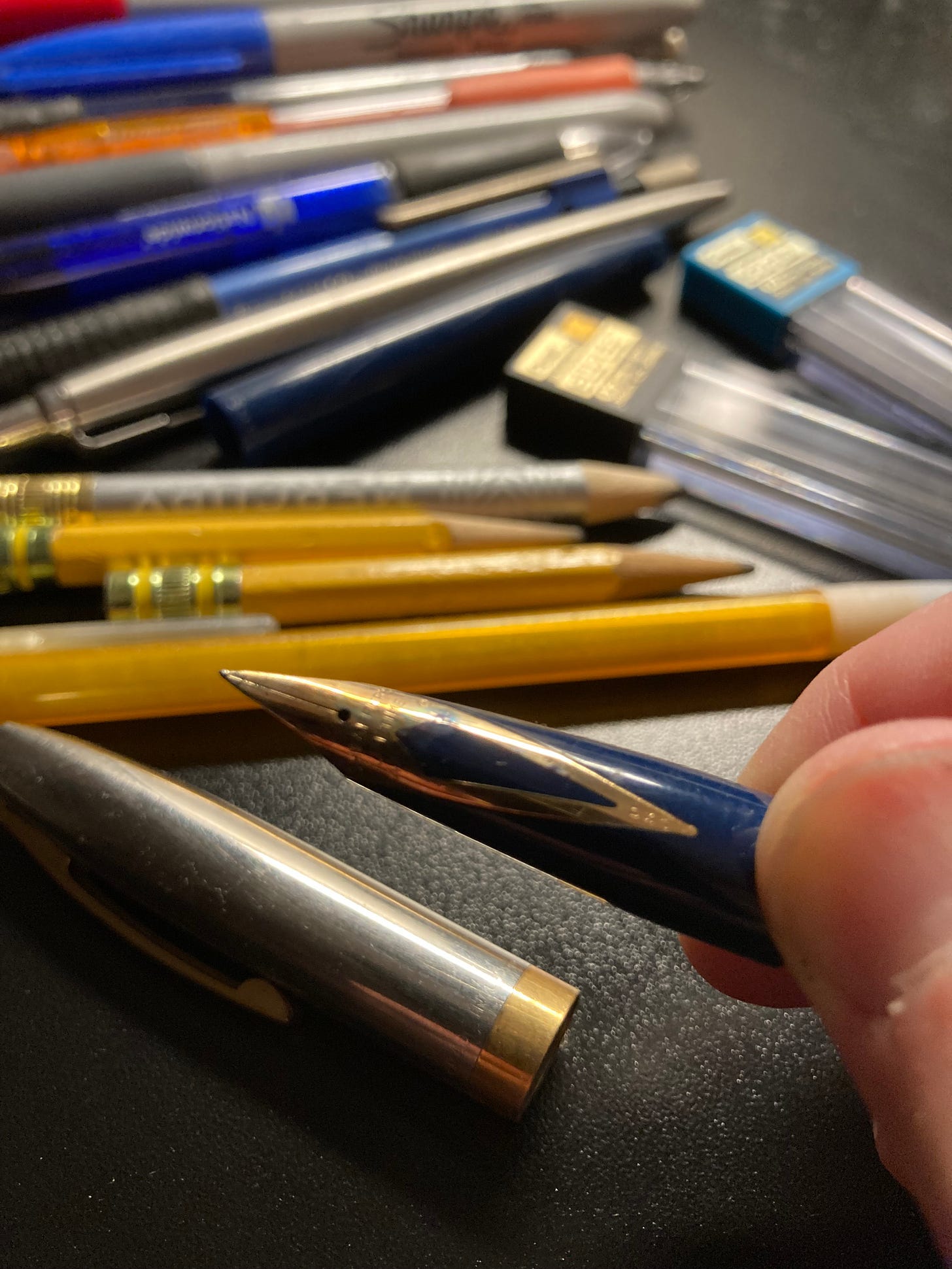With Pen in Hand: Abiding Words
Daytalking is also a tactile pleasure
“Somehow I started introducing writing into my drawings and, after a time, the language took over and I started getting very involved with the handwriting and then the look of the handwriting.”
—Patti Smith
Unlike Patti Smith, for me it starts with words.
Then the images creep in.
Case in point:

These images are fun to see, but of course reading the words (such as “Crooked Nationalism” and “Straight-Arrow Patriotism”) is vital, so they’re in my best handwritten lettering (more shortly on how I got into that). However, the word “Oyster” (lovely in and of itself—Oyyyy-ssss-ter) floats in mid-air as if suspended by the very clouds surrounding it.
Prior to 1989 (a decade earlier actually) I became curious about calligraphy after taking the required “Art Structure 101” class at my community college. I was buying ink cartridge fountain pens with detachable nibs so I could change the swoop and structure of the letters I was writing.
I just gotta say—holy shit, it was LOVE, baby.
Ascenders, descenders. San serif. Serif fonts. Ligatures. Letter spacing. Drop caps. Header casing. All caps—ALL CAPS. Lowercase—e.e. cummings-like shit. Neon lights big, bold, brassy, and blaring into the dark of night. Everything you saw became a blur but was still there locked in your nighttime imagination. Edward Gorey’s spidery handwritten captions and neatly drawn images. Sketchy, hashed-in drop shadows.
I. was. in. love. With all of it.
And love is a great place to start in any endeavor. The concept of an idea from hand to word to whatever must’ve started early because my late father Paul was an architect. Puzzling over Dad’s blueprints and home improvement plans, with his carefully lettered handwriting, nudged my curiosity—but here’s the deal with that: I quickly understood he did that because the wording must be clear to whomever is completing the plans so they can understand what to do.
That’s the point of hand-printed writing.
Cursive writing, however, was taught way back when I was in elementary school. Why we had to learn it is still a mystery to me.
But my “inner artist kid” loved the meditational aspect of it.
“Seeing my father's handwriting puts me in contact with the man he was at each stage of his life.”
—John Carter Cash
I write this thanks to fellow Substacker Mark Dykeman and his post “Curious Realizer—21st Century Rosetta Stone.” Rather than bog down his comments section, I told him I’d respond via a post—ta dah!
To anyone unfamiliar with the term, a Rosetta Stone, as I understand it, is a metaphor for anything that serves to explain something else, or maybe multiple somethings. A sort of code-breaking device. An instruction manual. A possible key to unlock other mysteries. A guidebook or translator. And maybe even a history lesson.
In his post Mark asks, “Should we throw our pens and pencils away? Should we bring back cursive writing? Or does it matter?”
Look, I’m old. I still jot down a work log on a legal tablet for my day job just so I can keep track of hours worked and the projects devoted to it. It’s faster than typing since it sits next to my computer, and it’s essentially for my own reference. Is my handwriting neat? Hell no! I don’t care. These legal tablets will be recycled at year’s end.
So why hand-write anything at all?
Pleasure, of course, if I take the time to enjoy it.
As referenced above in the Vicious Frieze collage: The feel of the pen in my hand. The color of the ink. The love of words scratched on paper.
Like the journals I wrote in for years.
Case in point:

My handwriting during those journal years (above is 1984-85, and I have 14 volumes of the chemistry books and maybe five diaries from the 1970s) was careful and precise for one reason.
I loved what I was living through at the time and wanted it preserved for posterity.
It began when I was a preteen as a way to vent—to speak to someone, anyone—about how I was feeling. Writing made me feel less alone. The pen was a future compatriot—Daytalking with myself at first, but later with others, through my writing. Cursive was the gateway drug to quicker writing, which also meant quicker thinking: Hand (check) + pen (in pocket) + paper (good ol’ notebook) + time (right now) = thoughts out of my head.
But if you needed to share your writing, you had to hand-print your words, so it was easily understood by others. The cursive was just for yourself (or if you were writing a love letter, for a special someone—kiss, kiss, mwah, mwah!). Hand-printing was about clarity. Direct statements. Poster boards with signs blasting, “HERE’S MY MESSAGE YOU GODDAMN MORONS” swinging madly out there on the street.
And if you’re lucky, happily pissing some people off.

That’s basically it. It was a loving acknowledgment of life as I was living it, all through the nib of a fountain pen.
Now, not feeling it so much.
So, you might ask… Well, why not?
“My writing looks like it’s ten steps behind my mind, and racing to always catch up.”
—Jarod Kintz
So, yeah. I have that original fountain pen from the early journal days. It’s dry (because it needs ink cartridges to work, and probably also needs a thorough cleaning) and so it’s been forgotten. I know, I know. Before we go there, we must go here.
Case in point:

I found I could chase my thoughts faster and catch up with them if I learned typewriting. That happened in high school, to my amazement and pleasure. The “quick brown fox jumps over the lazy dog” was a very cool thing to learn! It covered all the letters of the alphabet. From that you learned what QWERTY meant. It was astonishing.
I stayed late after typewriting class because—as a young wannabe writer—I instinctively knew it would pay off later. Even more, I liked the kinetic feeling of pounding a keyboard (later, the same love on a piano when I demanded my instructor teach me how to play like Thelonious Monk). As my WPM speed increased, my brain seemed to loll back in the driver’s seat and just enjoy the freakin’ sweet ride.
Typing was the shit!
So what happened to all my Amazing Adventures in Penmanship? I can answer that.
Age and impatience. Apparently a certain aspect of my personality was more patient when I was younger than I am now (crazy, huh?). Also, respect. You write patiently and respectfully when you’re writing to someone you love or about something you value. I do that here on this Substack, by typing and then rewriting, and then rewriting again before publishing. And then more rewriting. I’m a maniac about that. I’m even regretting writing that down. But now I’m happy to keep it. I’m a mess!
It recently occurred to me that I could invite you all, here on Substack, to send me your snail mail addresses and I would lovingly send you a handwritten and illustrated postcard. That might be something I do down the road with paid subscriptions (since there’s a cost attached to the idea). I don’t know.
It could also be disastrous. Which leads us to where we are now.
“The depressing thing about tennis is that no matter how good I get, I'll never be as good as a wall.”
—Mitch Hedberg
It’s called the Dunning-Kruger effect. I knew about it before I knew what it was called. The Internet has unleashed its minions upon us.
And it’s not a pretty picture.
Dad used to complain about former employers, saying to me something about “the Peter Principle,” which roughly translates as “everyone rises to their own level of incompetence.”
That Dunning-Kruger effect? Same sort of thing.
I guess what I’m trying to say is you can’t preach to a choir that’s waiting in a church on the dark side of the moon and which has no interest in bending their ears back toward Earth. And perhaps this is super cynical and I should be more hopeful (totally welcome your thoughts in the Comments), but maybe that “Cursive, Carefully Hand-written, Letter-perfect, Thoughtfully posted Missive Ship” has, well, already sailed.

So at last to answer Mark’s question, “Give up the pencils, pens, and throw them away?” Or do we reintroduce “cursive writing” into the larger culture of the 21st century?
No, and maybe yes.
The “no,” is for those people always riled and wild—cats who will run off the rails in their own personal crazy train whatever its cost to their sanity—or yours.
A qualified “yes”—for the budding artists, the perfumy love letter writers, the singsongy daydreamers, the patient ruminators and prickly cultural fumigators—people willing to slow the hell down—
And maybe smell—not the roses, but some freshly etched ink on a crisply lined sheet of paper.
Hey, by all means, write your hearts out. And feel free to use your hands.






Like you, I still prefer to handwrite notes, journals, etc. Unlike you, I have little style in my handwriting. (There is some break in the connection between my brain and my right hand.) Oh well. But having said that, it’s my style and mine alone. Helvetica is Helvetica no matter who pushes the key. But my sloppy, messy unstylish handwriting is unique to me and no one else.
And that’s probably a good thing!
Love this. Interesting idea, to reserve cursive writing for yourself. I like it, it makes a lot of sense to me. Reminds me of da Vinci’s backwards writing, which he supposedly used to add a level of privacy and security to his notes. Food for thought.